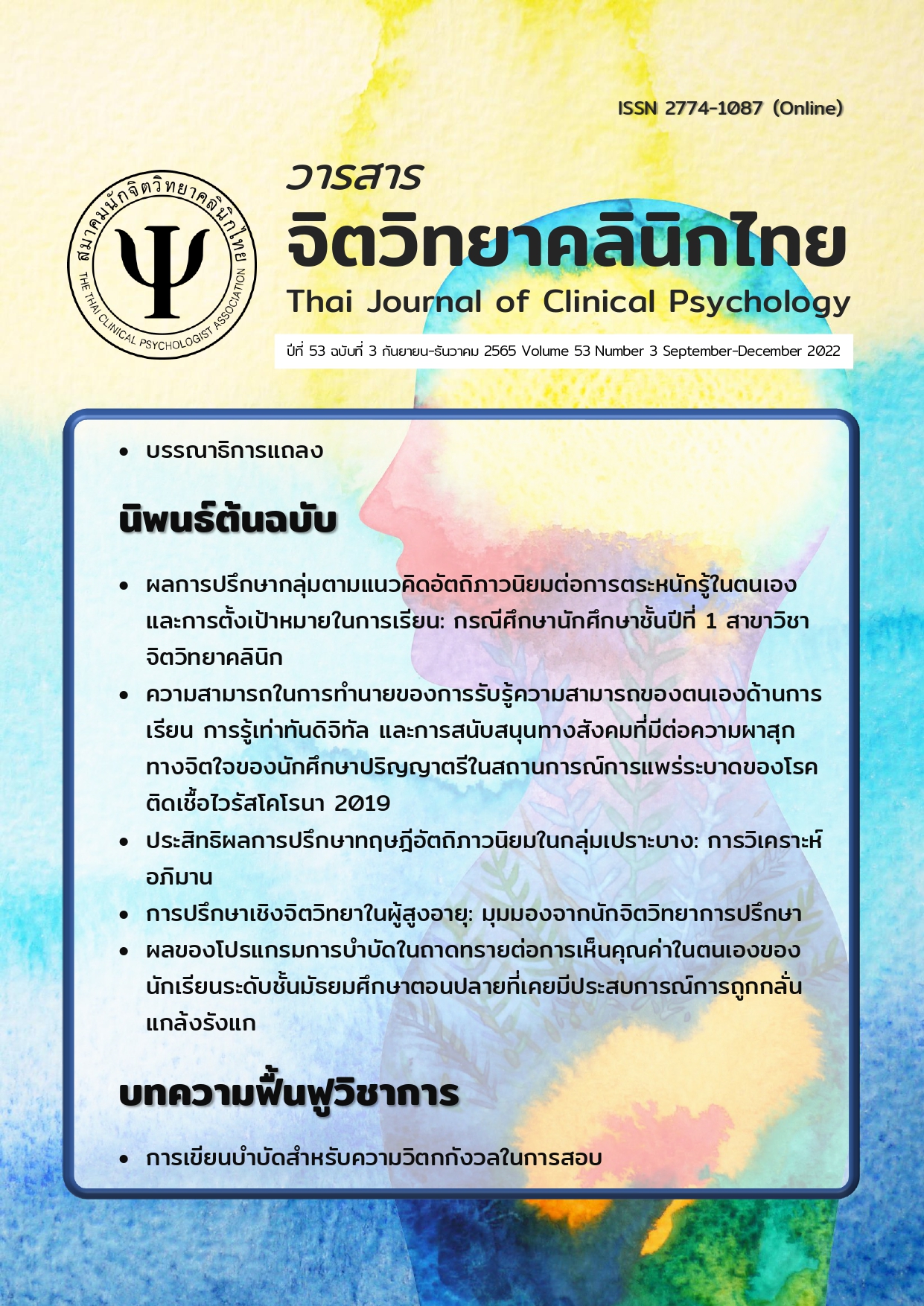The Effect of the Sandtray Therapy Program on Self-esteem of High School Victims of Bullying
Main Article Content
Abstract
Objective: The object of this single-case experimental A-B design was to examine the effectiveness of the sandtray therapy program on self-esteem of high-school victims of bullying. Materials and methods: The participants were five high school students who were victims of bullying and had negative self-esteem level assessed by Rosenberg self-esteem scale (Rosenberg, 2006). All participants were enrolled in the experiment in three phases. 1) In the Baseline phase (A) self-esteem data was collected once a week for 4 weeks without any intervention. 2) In the Intervention phase (B) the individual sandtray therapy program was introduced to participants once a week with 60 minutes each session for 8 weeks. Self-esteem data was gathered in every session. 3) In the follow-up phase (F) was measured self-esteem data after completing the sandtray therapy program once a week for 4 weeks. Data were analyzed by descriptive statistics, change in mean scores in each phase, graph visual analysis, and effect size. Results: Participants who participated in the sandtray therapy program showed higher levels of self-esteem in the intervention phase and follow-up phase when compared with the baseline phase. Conclusion: The sandtray therapy program could be one of supportive ways to improve self-esteem for high-school victims of bullying.
Article Details

This work is licensed under a Creative Commons Attribution-NonCommercial-NoDerivatives 4.0 International License.
เรื่องที่ลงตีพิมพ์ในวารสารจิตวิทยาคลินิกแล้วถือเป็นลิขสิทธิ์การเผยแพร่โดยวารสารจิตวิทยาคลินิกแต่เพียงผู้เดียว การตีพิมพ์หรือเผยแพร่ซ้ำในที่อื่นต้องได้รับอนุญาตจากกองบรรณาธิการวารสารฯ
References
Armstrong, S. A., Foster, R. D., Brown, T., & Davis, J. O. A. N. (2017). Humanistic sandtray therapy with children and
adults. In E. S. Leggett, J. N. Boswell, & N. C. C. LPC-S (Eds.), Directive play therapy: Theories and techniques
(pp. 217-253). Springer Publishing Company.
Corey, G. (2011) . Theory and practice of counseling and psychotherapy (9th ed.). Cengage Learning. Department of Mental Health. (2019, December 20) . 9 ways to cope when your child is bullied atschool. https://www.dmh.
go.th/news-dmh/view.asp?id=30122 (in Thai).
Desmond, K. J., Kindsvatter, A., Stahl, S., & Smith, H. (2 0 1 5 ) . Using creative techniques with children who have
experienced trauma. Journal of Creativity in Mental Health, 10(4 ), 439-455.
Garrett, M. (2014) . Beyond play therapy: Using the sandtray as an expressive arts intervention in counselling adult
clients. Asia Pacific Journal of Counselling and Psychotherapy, 5(1), 99-105.
Gladden, R. M., Vivolo-Kantor, A. M., Hamburger, M. E., & Lumpkin, C. D. (2014). Bullying surveillance among
youths: Uniform definitions for public health and recommended data elements. National Center for InjuryPrevention and Control, Centers for Disease Control and Prevention.
Gladding, S. T. (1992). Counseling as an art: The creative arts in counseling. American Association for Counseling
and Development.
Heatherton, T. F., & Wyland, C. L. (2003). Assessing self-esteem. In S. J. Lopez & C. R. Snyder (Eds.), Positive psychological assessment: A handbook of models and measures (pp. 219-233). American Psychological Association.
Hinduja, S., & Patchin, J. W. (2015). Bullying beyond the schoolyard: Preventing and responding to cyberbullying (2nd
ed., pp. 45-68). Corwin Press-Sage Publication.
Homeyer, L. E., & Sweeney, D. S. (2017). Sandtray therapy: A practical manual (3rd ed.). Routledge.
Ma, H.-H. (2006). An alternative method for quantitative synthesis of single-subject researches: Percentage of data points exceeding the median. Behavior modification, 30(5), 598-617.
Matsui, T., Tsuzuki, Y., Kakuyama, T., & Onglatco, M.-L. (1996). Long-term outcomes of early victimization by
peers among Japanese male university students: Model of a vicious cycle. Psychological Reports,
(3), 711-720.
Minev, M., Petrova, B., Mineva, K., Petkova, M., & Strebkova, R. (2018). Self-esteem in adolescents. Trakia Journal of
Sciences, 16(2), 114-118.
O’Moore, M., & Kirkham, C. (2001) . Selfesteem and its relationship to bullying behaviour. Aggressive Behavior: Official Journal of the International Society for Research on Aggression, 27(4), 269-283.
Olweus, D. (1994). Bully at school: Long-term outcomes for the victims and an effective school-based intervention
program. In L. Huesmann (Ed.), Aggressive behavior: Current perspectives (pp. 97-129). Plenum Press.
Poston, B. (2009) . Maslow’s hierarchy of needs. The surgical technologist,41(8), 347-353.
Rigby, K. (2005). Bullying in schools and the mental health of children. Journal of Psychologists and Counsellors in
Schools, 15(2), 195-208.
Rosenberg, M. (2006). Rosenberg self-esteem scale (RSE). In J. Ciarrochi & L. Bilich (Eds.), Acceptance and commitment therapy. Measures package (pp. 61). University of Wollongong, School of Psychology.
Shen, Y.-P., & Armstrong, S. A. (2008). Impact of group sandtray therapy on the self-esteem of young adolescent girls. The Journal for Specialists in Group Work, 33(2), 118-137.
Wolke, D., & Lereya, S. T. (2015). Long-term effects of bullying. Archives of Disease in Childhood, 100(9), 879-885.

